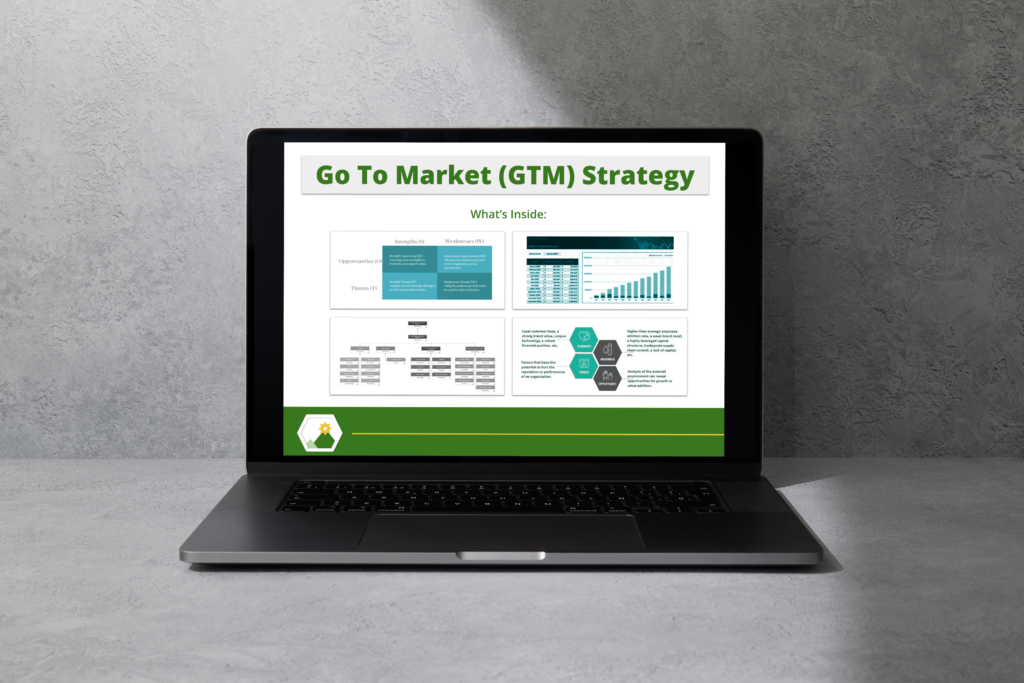We all know the feeling, when you’re struck with an incredible idea. An idea that will fix a well-known problem, do something in a brand new way, maybe even a product that changes the world for the better.
The founder’s mind races with endless scenarios and potential outcomes. They are filled with a sense of anticipation and wonder as they contemplate the impact their product could have on the world.
However, at this early stage, the idea remains untamed, waiting to be molded and refined into a viable business venture. The path to commercialization may be uncertain – but the prospect of transforming a simple product idea into a successful revenue driving business is undeniably enticing.
Founders of mission-driven companies know these feelings well, and they know that this phase needs to quickly give way to action, for three key reasons:

- The go-to-market strategy serves as a roadmap outlining the strategic direction for your business. It enables you to define your target market, identify your competition, and establish a pricing strategy. Without it, it becomes difficult to position effectively in the market and differentiate oneself from competitors.
- The go-to-market strategy helps define the financial viability of your business idea. Market research and analysis of cost projections will help you determine if your idea is economically feasible and if there is a demand for your product or service. It does this not just for the founding team, but also for investors.
- The go-to-market strategy offers a framework to set realistic goals and objectives for the business. It enables you to develop a clear marketing strategy, determine sales forecasts, and allocate resources effectively. It becomes a foundational asset to track progress and make informed decisions.
Key questions to defining the go-to-market strategy
If you do not have a clear sense of the sales potential of your product, your business is exposed in a few ways.
It will be difficult to make informed decisions about how much money to invest in product development, marketing, and sales. It becomes more complicated to develop an effective sales and marketing strategy, without knowing how much the target market is willing to pay for your product. You’ll be challenged in prioritizing within your product roadmap, with the risk of losing focus on your core goals. Most of all, investors will pick up on the scent, making it harder to secure the funding you need.
A founder or leader of a Seed stage company will often ask themselves certain questions to address this challenge:
Evaluation of Product-Market Fit
- What is the benefit customers get from using this product?
- How would a customer feel if they could no longer use this product?
- How do customers discover this product?
- If the product were discontinued, what would people use as an alternative?
- Is the product, in its current state, something the customer actually wants?
Total Addressable Market (TAM)
- How big is the market for our product or service?
- How fast is the market growing, and what trends are driving market growth?
- What are the barriers to entry in the market?
- What is the competitive landscape?
- What is our market share?
Customer Segment Analysis
- What are the distinct segments of our customer base?
- How do the customer segments differ in needs, pain points, and behaviors?
- Which segments are most profitable?
- Which segments are growing the fastest?
- How can the product be tailored to the needs of each customer segment?
Competitive Analysis
- Who are our direct and indirect competitors, and what products/services do they offer?
- How do those products compare to us in features, pricing, customer satisfaction?
- What are competitors’ pricing strategies?
- What are their marketing and sales strategies?
- How are they doing customer acquisition and retention?
- Where is there a vacuum that we could step in to fill?
Understanding Go-To-Market Strategy For Social Impact
To define the product’s revenue potential for social impact, consider the following factors:
The market size of the social problem that your product solves. The larger the problem, the greater the potential for revenue. The market size for residential solar power in the US, for example, is estimated at $14 billion with 15% projected annual growth. By comparison, total retail sales of plant-based foods are over $7.4 billion, and growing at 6%.
The number of people who are affected by the social problem. The more people who are affected, the greater the potential market for your product. Needless to say, there are global problems affecting the planet’s entire population of 8.1 billion people, starting with climate change. Others can be defined more narrowly. For example, with 66% of the American population considered financially illiterate, that means about 218 million people’s lives could be impacted with access to financial education.
The willingness of people to pay for a solution to the social problem. This depends on the severity of the problem and the effectiveness of your product. In 2022, 10% of passenger vehicles sold globally were all-electric, a significant increase from five years earlier, when the percentage was only 1%. That still leaves a vast majority of people not willing to pay the price. Recycling of municipal waste, however, is much more widely adopted: a number of countries recycle more than 50% of their waste, including Germany, Austria and Switzerland.
The cost of producing and delivering your product. This will determine how much you can charge for your product and still make a profit. Consider carbon capture and storage, whose significant infrastructure changes would incur high costs of between $60 and $250 per ton of CO2. The government in the UK, for example, has set a target to capture between 20 to 30 million tons of CO2 a year – bringing the cost of this solution to as much as $7.5 billion. This is much more expensive than providing new textbooks to every public school in the UK, which would be around $2.0 billion.
Our Approach To Defining The Go-To-Market Strategy
We start by identifying the segments that are most likely to pay for your product and how much they are willing to pay. This includes surveying potential customers to get their feedback on the product, followed by an analysis of how much competitors are charging for similar products.
Next we’ll build a revenue model to identify exactly how to generate revenue from your product. This includes a review of sales channels and pricing models. This model will be offset against a cost model, to understand how much it costs to produce and deliver your product – helping you to determine how much you can charge to turn a profit.
Evaluation of Product-Market Fit
- Research market needs & match against product’s current value proposition
- Conduct surveys & interviews (internal/external) to understand existing patterns of product usage, satisfaction and frustration
- Evaluate patterns of product/feature adoption, customer growth and satisfaction
Total Addressable Market (TAM) & Customer Segment Analysis
- Review of internal sales data & external industry intelligence (incl. competitive footprint, complementary/replacement products, customer adoption trends)
- Identification of reasonable targets for market penetration and gross revenue
- Analysis of customer data to isolate distinct buyer groups
Competitive Analysis
- Identify direct competitors & indirect (offering different solution but competing for the same attention/budget)
- Highlight key competitive features, benefits, pricing and packaging
- Evaluate customer reviews to capture positioning insights
- Analyze competitive sales & marketing strategies incl. customer acquisition/retention & creative/channels
- Benchmark company strengths/weaknesses vs. competition & outline opportunities for differentiation
Solutions For Defining The Go-To-Market Strategy
Behind every good business is a great plan. But if your plan is built on imperfect customer or market insight, an incomplete proof of concept, or other blind spots – you’ll just end up spinning your wheels.
Give your organization a comprehensive roadmap for how you’ll achieve your aggressive goals.
Our Process
- Review of all internal customer intelligence & marketing plans/programs
- Review of targets, sales activity and performance, augmented by team member interviews
- Evaluation of documented product-market fit, competitive dynamics & future product roadmap
- Survey of current sales team methodologies, competencies and incentives
- Synthesis of all findings into stop/start/continue recommendation framework

This process includes periodic interim reviews with key stakeholders, to solicit feedback guiding the overall direction of the project.
Deliverables
- SWOT analysis delivered mid-term, to focus further discovery
- Scorecard documenting areas of opportunity & actionable next steps to improve
- Recommendations for further customer insight, revisions to marketing plans
- Summarized top asks of leadership team, incl. marketing, product, finance, legal, HR
Impact
- Clear direction across the entire organization
- Honest dialogue about the top roadblocks to success
Click for more information on the Go To Market Strategy, or get in touch.
Other Revenue Growth Challenges For Seed Stage Companies
This discussion about how to define a Go-To-Market Strategy is one post in an 8-part series about revenue growth challenges for seed stage companies. See below for how to address other common revenue challenges:



0 Comments